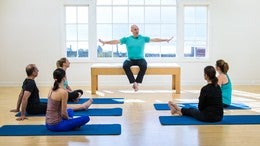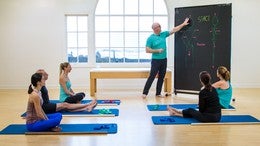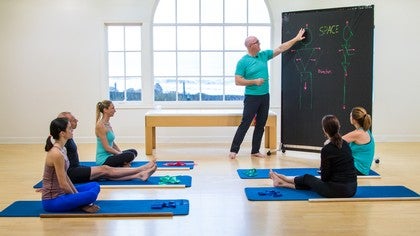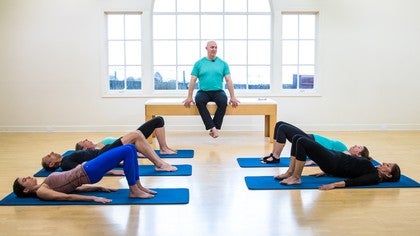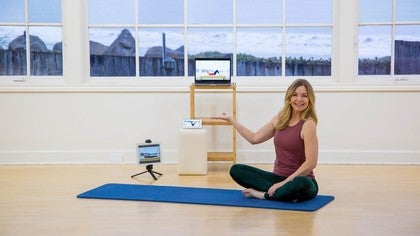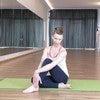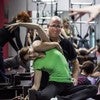Description
About This Video
Transcript
Read Full Transcript
My name is Brandon Anderson and we're talking about the four tips of how to optimize our time on is anytime, especially those of you that are at home and the first one we talked about the why, how important it was just to get up and move, just to be able to make that happen. Make the commitment to get on the channel every day, do something no matter what. The second one was that there's really no right or wrong, it's just whether we're efficient, more efficient, less efficient in our movement and that we're always having the goal to increase our efficiency, increase our awareness of our ability to move. And then we had some fun exercises looking at space of how do we organize ourselves in space to increase that internal and external awareness. And this last one we're looking at efficiency and efficiency is really about again, this awareness process of how much energy are we using to be able to do the exercise. And this is a very simple, and it will be very efficient even in this little tip here, is that if you can do the exercise with half as much energy, then that means you were not being efficient when you were doing it at first.
And then try to do it again with half as much energy until you no longer can do it. So I want to do the experiment with the simple bridge. So I'm going to have you get on your backs, knees bent feet on the ground. You're going to do this at home as well. And I want you to listen closely to your body. So we're going to exaggerate in the other direction.
So what I want you to do is I want you to push your arms down into the floor a little bit. I want you to clench your teeth. I want you to feel the tension across the front of your chest. I want you to squeeze your glutes together, tighten the hamstrings, push your feet into the floor and roll your spine up off the mat until your waist between the shoulder blades. Yeah. So we're exaggerating in the other direction. And then when I take a deep breath in, inhale all the way and exhale, bringing the ribs down, one vertebrae at a time, holding onto that tension in your jaw, your body all the way down, right until the bottom comes back down. Now I know that didn't feel good, but there was the exaggeration and I want you to experience.
So now let's do the same thing with half as much energy. So we're going to still feel the hands still feel the shoulders still for the jaw a little bit. Still feel the pelvis and the glutes and the hamstrings, but about half as much. And let's see what happens when we do the bridge. Now rolling the spine up with an exhalation up into the weights between the shoulder laid, still fill in the mat, but about half as much energy and then roll back down. The second part of the efficiency lab is what muscles can I actually turn off and still do the movement successfully? So do you need your job muscles to do a bridge?
Do you need your neck muscles to do a bridge? Do you need to push your hands into the mat, your shoulders, into the mat, to the bridge? The answer from my point of view is no. So we're going to do the bridge now by eliminating the jar muscles, the neck, the shoulder, the chest muscles, the hands in the mat. Relax those down. Very soft. Relax the jar. Relax your eyes into your head. Take a deep breath in and begin to roll the spine up off the mat.
So we've eliminated unnecessary muscles, unnecessary tension to be able to do the bridge rolling back down. Now in this next variation of it, I'm going to have you do the same thing, but this time go half as much energy again. So we know we need to use the legs. We know we need to use the glutes in the back of the legs, the hamstrings. We know we need to articulate the spine.
There might be a little bit of abdominal contraction, but can you do the exercise with half as much energy again? So making it very fluid, trying to move that body, rolling it up the spine nice and easy. Using your breath to do it less and less energy each time. And Nice breath on top. And now let's move into different language. Let's go into softening and allowing the ver the ribs to soften and slide down towards the mat, the Vertebra to slide down towards the Mat.
One Vertebra at a time as you exhale and return the pelvis again, doing a quick check. How much tension do you have in your feet? How much tension do you have in your hands, your arms, your jar, your face, your neck? See if you can do this bridge one more time with half as much tension, half as much energy. So it should just be a very subtle flowing, lifting up. Take a breath up, and then exhale. Roll in Baghdad. Now at home, the idea here is that you keep going to this point until you get to the point where it's like if I do any less energy, my bottom is not going to come up off of the mat. Can we go to that point?
So it'd be so relaxed that you have the idea of rolling up, but you're not going to use enough strength to roll the bottom up. So you gotta be really relaxed and realize that would be a little too love energy. So we want to feel the other end of it as if you were paralyzed or you'd had an epidural and your legs were not working, they were shut off. And now think of doing the bridge and realizing you don't have any power at all to do the bridge, right? Nothing can push up. So that would be too little energy.
So let's go back after all of those and find what you think is the optimal amount of energy to do a successful bridge that is optimally efficient and it has that beautiful continuum of movement between the Vertebra and the tissues that surround it on your own time. Exhale, roll the pelvis up using as little as necessary, taking a breath up on top, sliding and allowing any kind of restrictions around the spine to let go, right? Keeping the suspension beautiful. Now if we combine that efficient a bridge with a little bit of spatial guidance, so we think of direction, the directions we're going to be sending the knees towards the center of the room and the head back towards the wall behind you. So we have the direction. We're going to bring the body parts closer to the central axis. We're going to be efficient in role in the body after the last one. Xcel role in the pelvis hub with the direction, knees reaching away, taking a breath, and then exhale.
Almost like the elastic band holding your knees is still holding your knees away as you feel that length in that direction in the axial skeleton, allowing the spine to roll back down into this position and if you were watching the quality of the bridges of our volunteers here today, you would see that the last bridge was by far the highest quality. Collectively as a group in doing a articulating bridge on the floor. I hope that you can appreciate some of these tips that you can find efficiency in your movement. Remember the goal is to fi filled with energy, to have efficiency, to enjoy the movement, to find joy and happiness in the movement. This is Brandon Anderson. Bring you tips to optimize a, you're polite at anytime experience and we'll see in the future.
Pilates at Home - Playlist 1: Optimize Your Online Experience
Comments
You need to be a subscriber to post a comment.
Please Log In or Create an Account to start your free trial.
